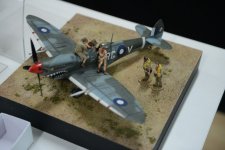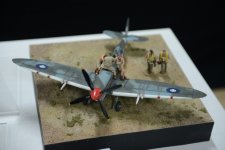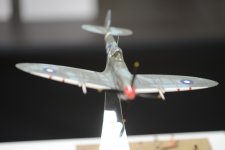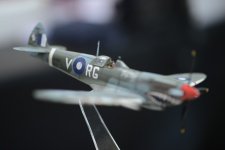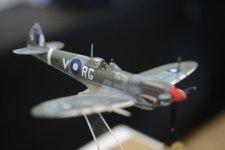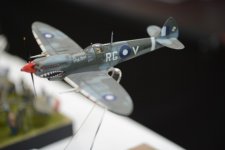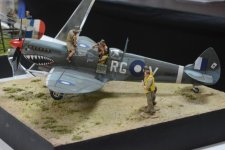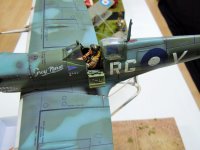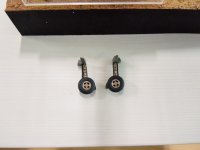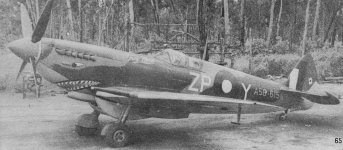You are using an out of date browser. It may not display this or other websites correctly.
You should upgrade or use an alternative browser.
You should upgrade or use an alternative browser.
Singapore Meet & Greet - Spitfire (1 Viewer)
- Thread starter ChrisTay
- Start date
ivanmoe
Command Sergeant Major
- Joined
- Feb 2, 2013
- Messages
- 2,959
Wasn't sure how this was going to look on a stand, but JJ resolved the issue in the collector's favor by making the landing gear positionable!
-Moe
ivanmoe
Command Sergeant Major
- Joined
- Feb 2, 2013
- Messages
- 2,959
View attachment 218016
A close up of the cockpit of the JJD "Pacific Spitfire".
Mk VIII Spitfire of Royal Australian Air Force, No. 457 Squadron (nicknamed Grey Nurse Squadron).
Raymond.
Thanks for the pic, Raymond. The model looks TERRIFIC, but this is gonna be a tough space to inhabit, as the rivet-counting element is FEARSOME.{eek3}
-Moe
It does look a real beauty, and me swearing I'd never buy another Spitfire unless someone did a RAAF Pacific version...^&cool -- AlThanks for the pic, Raymond. The model looks TERRIFIC, but this is gonna be a tough space to inhabit, as the rivet-counting element is FEARSOME.{eek3}
-Moe
Go for Broke
Sergeant Major
- Joined
- Jun 18, 2008
- Messages
- 1,619
I'm not plane guy like Lancer or Ivanmoe, but that is one sweet spitfire. Especially flying on the stand. I may have to consider getting this one.
TomNT
Lieutenant Colonel
- Joined
- May 7, 2011
- Messages
- 7,986
This Spit looks awesome! I don't collect aircraft but I may have to grab this one! As already mentioned by Raymond, this aircraft has RAAF 457 squadron markings and they were based in Darwin (where I live) and operated from an airfield in Batchelor just south of Darwin from the 20th of January 1943.
Tom
Tom
OldDragon
Master Sergeant
- Joined
- Dec 14, 2006
- Messages
- 1,345
Another shot of the JJD Pacific Spitfire in flight.
You can easily switch from landing gear up or down depending on choice of display.
The landing gear attaches by magnet.
Raymond.
All we need now is ... an interchangable "spinning props", wouldn't that be a dream.
Bests
OD
TomNT
Lieutenant Colonel
- Joined
- May 7, 2011
- Messages
- 7,986
This Spit looks awesome! I don't collect aircraft but I may have to grab this one! As already mentioned by Raymond, this aircraft has RAAF 457 squadron markings and they were based in Darwin (where I live) and operated from an airfield in Batchelor just south of Darwin from the 20th of January 1943.
Tom
Here is an historical photo of one of the Grey Nurse Spit's of 457 squadron at another airstrip called Livingston which is also near Darwin. It wasn't uncommon for aircraft to use other airstrips during the bombing of Darwin campaign by the Japanese. The Australian military built quite a few airstrips just outside of Darwin as the main aerodrome in the town was being heavily bombed. These airstrips still exist and they are located on the Stuart Highway which is the main road that connects Darwin to other parts of Australia.
Tom
Attachments
wwiibuff
Lieutenant Colonel
- Joined
- Mar 27, 2009
- Messages
- 7,600
This Spit looks awesome! I don't collect aircraft but I may have to grab this one! As already mentioned by Raymond, this aircraft has RAAF 457 squadron markings and they were based in Darwin (where I live) and operated from an airfield in Batchelor just south of Darwin from the 20th of January 1943.
Tom
This is an excellent looking Spit. That's cool Tom about this squadron at one time being based in Darwin where you live. I may have to get one of these.
The Military Workshop
1st Lieutenant
- Joined
- Jul 31, 2005
- Messages
- 4,778
This Spitfire is one of the most well known Australian WW2 aircraft as it pilot was Wing Commander Robert Henry Maxwell (Bobby) Gibbes, DSO, DFC & Bar, OAM (6 May 1916 – 11 April 2007. His markings in the desert war were also well known at it featured a kangaroo kicking a daschund. He had a very interesting flying career post WW2 and flew a JU52 from Europe to New Guinea for his own airline. His airline used 3 JU52's.
Had the pleasure of meeting him at an airshow as he signed some prints I published. It was a sad occasion for him as he had just been told he could no longer fly solo. He was selling a small aircraft he had assembled in his house but could no longer fly as only a one seater. The buyer subsequently painted it to represent his markings. I subsequently discussed with him my mixed feelings about meeting a Heinkle pilot who flew with V1 rockets underneath. He mentioned he had met a Luftwaffe pilot who had shot him down and had no ill feeling towards him as just doing his job.
He was a leading Australian fighter ace of World War II, and the longest-serving wartime commanding officer of No. 3 Squadron RAAF. He was officially credited with 10¼ aerial victories, although his score is often reported as 12, including two shared. Gibbes was also credited with five aircraft probably destroyed, and a further 16 damaged. He commanded No. 3 Squadron in North Africa from February 1942 to April 1943, apart from a brief period when he was injured.
Born in rural New South Wales, Gibbes worked as a jackaroo and salesman before joining the Royal Australian Air Force in February 1940. Posted to the Middle East in April 1941, he flew with No. 3 Squadron in the Syria–Lebanon Campaign, and became commanding officer during the Western Desert Campaign, where his leadership and fighting skills earned him the Distinguished Service Order and the Distinguished Flying Cross and Bar. Subsequently posted to the South West Pacific, he served with No. 80 Wing of the Australian First Tactical Air Force, and took part in the "Morotai Mutiny" of April 1945. After the war he spent many years in New Guinea developing local industry, for which he was awarded the Medal of the Order of Australia in 2004. He continued to fly until the age of 85, and died five years later in 2007.
https://en.wikipedia.org/wiki/Bobby_Gibbes
Had the pleasure of meeting him at an airshow as he signed some prints I published. It was a sad occasion for him as he had just been told he could no longer fly solo. He was selling a small aircraft he had assembled in his house but could no longer fly as only a one seater. The buyer subsequently painted it to represent his markings. I subsequently discussed with him my mixed feelings about meeting a Heinkle pilot who flew with V1 rockets underneath. He mentioned he had met a Luftwaffe pilot who had shot him down and had no ill feeling towards him as just doing his job.
He was a leading Australian fighter ace of World War II, and the longest-serving wartime commanding officer of No. 3 Squadron RAAF. He was officially credited with 10¼ aerial victories, although his score is often reported as 12, including two shared. Gibbes was also credited with five aircraft probably destroyed, and a further 16 damaged. He commanded No. 3 Squadron in North Africa from February 1942 to April 1943, apart from a brief period when he was injured.
Born in rural New South Wales, Gibbes worked as a jackaroo and salesman before joining the Royal Australian Air Force in February 1940. Posted to the Middle East in April 1941, he flew with No. 3 Squadron in the Syria–Lebanon Campaign, and became commanding officer during the Western Desert Campaign, where his leadership and fighting skills earned him the Distinguished Service Order and the Distinguished Flying Cross and Bar. Subsequently posted to the South West Pacific, he served with No. 80 Wing of the Australian First Tactical Air Force, and took part in the "Morotai Mutiny" of April 1945. After the war he spent many years in New Guinea developing local industry, for which he was awarded the Medal of the Order of Australia in 2004. He continued to fly until the age of 85, and died five years later in 2007.
https://en.wikipedia.org/wiki/Bobby_Gibbes
uksubs
Lieutenant Colonel
- Joined
- Nov 5, 2006
- Messages
- 7,050
Tom bit more information on the Spitfire MkVIIIHere is an historical photo of one of the Grey Nurse Spit's of 457 squadron at another airstrip called Livingston which is also near Darwin. It wasn't uncommon for aircraft to use other airstrips during the bombing of Darwin campaign by the Japanese. The Australian military built quite a few airstrips just outside of Darwin as the main aerodrome in the town was being heavily bombed. These airstrips still exist and they are located on the Stuart Highway which is the main road that connects Darwin to other parts of Australia.
Tom
Spitfire MkVIII
The MkV Spitfires were worn out from over a year of constant combat operations. The squadron got the order from the RAAF Headquarters to come back to Australia to re-equip with the new MkVIIIs which is often considered as the best of the Spitfire marks.
The initial MkVIIIs had corrosion issues which had also been found in the other Australian squadrons as well as RAF squadrons in India. New parts were fabricated in Amberley but Britain did not help and the RAAF manufacturing and supply system was slow. A similar issue occurred with the drop tanks. All these issues helped delay the squadron returning to the South West Pacific front.
The squadron relocated to Morotai which is an island south of the Philippines. The aircraft flew sweeps, scrambles and when needed strafing runs. A captured Zero was flown to Morotai in March of 1945 where several big times Australian pilots, including Clive Caldwell, flew the Zero against the Spitfires.
By mid-1945 the Australians in Morotai were far behind the leading edge of the war against the Japanese. The experienced pilots were not happy about it but it was the end result of the American and in particular MacArthur's policy toward Australia where he wanted American forces, and in particular his forces, were at the fore-front of the war effort and hence media - which was all important to MacArthur.
Despite this 79 Squadron continued constant operations in support of the Australian and American forces in Morotai. One of the missions they had to flow was destroying Japanese barges. This was partly because this was all there was left of Japanese sea power in this area. The squadron also flew strafing bombing missions against everything they could. This occasionally was airfields but a lot of the time it was anything that fired at them.
With the end of the war the squadron was involved in leaflet drops telling the Japanese troops that had been bypassed that the war was over. The Spitfires were flown back to Australia once peace had settled in and the squadron was disbanded.
Users who are viewing this thread
Total: 2 (members: 0, guests: 2)


